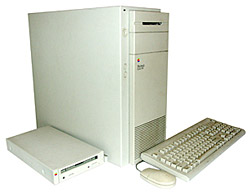The Video Revolution
The invention of video tape recording and lightweight video cameras soon resulted in the displacement of 8mm film as the primary means for amateurs to capture video. But editing video tape recordings was difficult.
In 1989 Avid introduced plug-in cards for the Macintosh which could convert video tape to digital format for editing and playback, but cost confined this technology to production studios.
 In 1991 Apple introduced QuickTime software that allowed the Macintosh Quadra 900 to create, edit and display
real time video if an analog to digital converter card was installed to facilitate video input. By 1993 the
Macintosh AV series was supplied with the necessary cards to capture analog video recordings in digital format.
The video revolution had arrived for amateurs, albeit well-heeled amateurs. Over the next few years this
hardware became more reasonably priced and movie editing for all was within reach.
In 1991 Apple introduced QuickTime software that allowed the Macintosh Quadra 900 to create, edit and display
real time video if an analog to digital converter card was installed to facilitate video input. By 1993 the
Macintosh AV series was supplied with the necessary cards to capture analog video recordings in digital format.
The video revolution had arrived for amateurs, albeit well-heeled amateurs. Over the next few years this
hardware became more reasonably priced and movie editing for all was within reach.
Today every Macintosh includes iMovie software, which supports video acquisition, editing and output, usually by burning straight to DVD. For professionals, Apple's Final Cut Studio supports high-end video editing in High Definition along with companion applications that support sound editing and animation.
<< back to The Apple Effect homepage
^ top of page
Five revolutions that changed your life
 Video
Revolution podcast
Video
Revolution podcast
To download these files onto your computer, control-click (right-click) on the link and select "download linked file" (Safari) or "save link as" (Firefox). Double-click or drag the file into iTunes and it will play.
Brian Livingston talks about how the Quadra 900 revolutionised his life:
 internet macintosh user group!
internet macintosh user group!